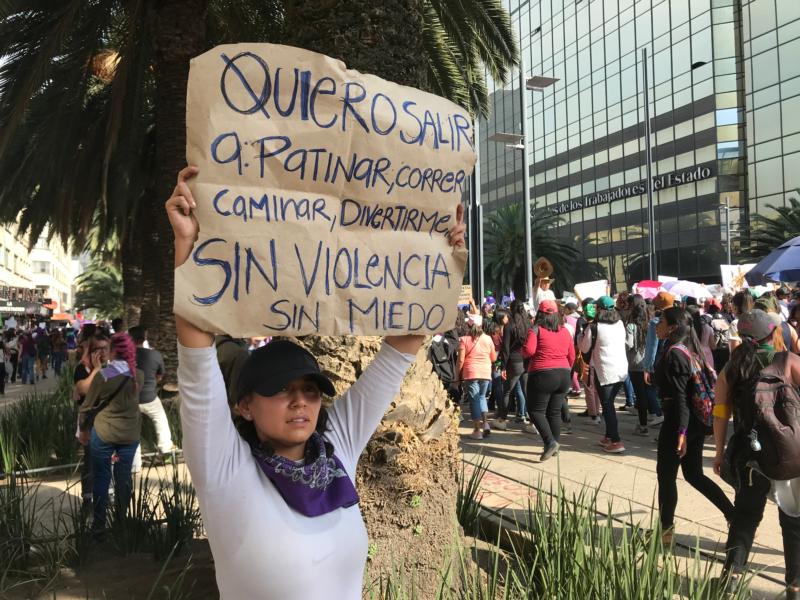MEXICO CITY (CNS) — Jackie Campbell had a mural of a murdered woman painted above her home in the northern Mexican city of Saltillo, where she works as spokeswoman for the Catholic diocese and is known as a human rights activist.
Over the winter, municipal officials told her to remove the mural, which remembered the life of Brenda Nail Gonzalez Montelongo, whose ex-partner threatened her with death. Gonzalez Montelongo disappeared and was found tortured and murdered after leaving her home for her factory job in the border town of Piedras Negras in October 2018.
Authorities told Campbell the use of purple paint for the mural violated municipal regulations. But she suspected the mayor had other motives for wanting the mural removed.
[hotblock]
“It’s a lack of seriousness and understanding,” she said. “They don’t know what feminism is, nor what femicides are,” Campbell said, referring to a term in Mexico for the murders of women and girls for gender reasons. “It’s the all the same repressive, patriarchal system.”
The ongoing atrocity of femicides and a litany of indignities — ranging from workplace harassment to insecurity in the street to constant groping on public transport — have pushed women of all worldviews, political persuasions and religious confessions, including Catholics, to protest the way they are treated in a country known for its machismo culture.
Tens of thousands of women protested on March 8, International Women’s Day, in cities across Mexico. Millions more participated in a national strike — promoted as “a day without women” — March 9 as women disappeared from public places: not going to work or school, not patronizing any businesses, and largely staying offline.
Campbell cited a simple reason for her strike participation: “Official statistics say that 10 women are murdered each day.”
Some Mexican dioceses and Catholic universities allowed female employees to participate in the strike. Women religious also expressed ample support, according to Oblate Sister Carmen Ugarte Garcia.
“The deep meaning of (the strike) is that violence against women has to be eradicated — not just diminished — so that all men and women can live together peacefully,” Sister Carmen told Catholic News Service. “There is a history of machismo and violence in Mexico (which is) regrettably maintained in many homes.”
[tower]
With the successful strike and an increasing consciousness on women’s issues, Sister Carmen said: “I firmly believe that this day is marking a milestone in Mexican history. We’re starting to forge a new social order of equality.”
The Mexican bishops’ conference also expressed support for the strike, saying that a spate of recent femicides “call us to reflect on the current challenges of fundamental human rights in our country.”
In a Feb. 25 statement, the bishops also called for the protests “not to divide us over political or ideological questions or religious expressions,” but rather “all protests or public expressions open the door to dialogue in the quest to build a more equitable society that guarantees the rights of all persons, principally women, so they can live without fear.”
The statement referred to divisions occurring inside the church and in the country’s political arena.
Some conservative Catholics expressed uneasiness with the women’s march over the abortion issue and the presence of masked protesters, who have vandalized shops, monuments and public buildings, including churches.
Cardinal Juan Sandoval Iniguez of Guadalajara called the strike “anti-male,” while accusing the organizers of “wanting to open the road to abortion” and “gain ground politically.”
President Andres Manuel Lopez Obrador and his supporters also spoke suspiciously of the protest and accused “conservatives” — a word the self-proclaimed leftist calls his opponents — of showing a sudden interest in women’s issues after years of indifference.
A female Cabinet minister, Irma Sandoval, mused that striking women would be tempted “do the dishes” while away from work.
Mexican women went on strike anyway. The streets of Mexico City were unusually quiet and lacking traffic, while stores reported light sales. Many subway stations could not sell tickets as female vendors stayed home.
[hotblock2]
The strike was preceded by the massive marches, in which women waved signs like: “Excuse the inconvenience, but they’re killing us,” and, “What reaps a country that kills 10 women a day?”
“I’m here because the government doesn’t do anything to defend us,” said Joanely Martinez, 33, a marketing employee in Mexico City.
“I’m fed up with the way my friends are mistreated,” said Veronica Zamudio, 29, a video editor at the protests.
“It’s our culture,” she added. “The problem is we are brought up to believe women are worth less than men.”
The marches were boisterous and mostly peaceful, although packs of masked women broke windows and spray-painted some buildings.
Protesters pounded on the door, broke windows and painted the exterior of the cathedral in the northwestern city of Hermosillo during an evening Mass.
Volunteers immediately went to work repairing the damage. The archdiocese, in a March 9 statement signed by Archbishop Ruy Rendon Leal, called for “men and women of good will to continue building a better society, where justice, respect, fraternity and peace prevail.”
PREVIOUS: Sodalitium movement should be ‘dissolved,’ cardinal says
NEXT: Pope entrusts world threatened by coronavirus pandemic to Mary




Share this story